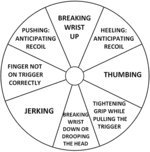- Messages
- 7,315
- Reactions
- 23,250
LOL, reminds me of when I bought my Mac in .45 (Class III) and took a buddy to shoot it. He was trying it in semi with stock folded. Trying to shoot it as a large handgun. That heavy bolt falling would make him pull and hit wayyyy high. After a few shots he said "how the hell do you hit anything with this". I put it on full auto and said "try it now". The grin on his face from ear to ear was hilarious.
Open bolt goodness.












